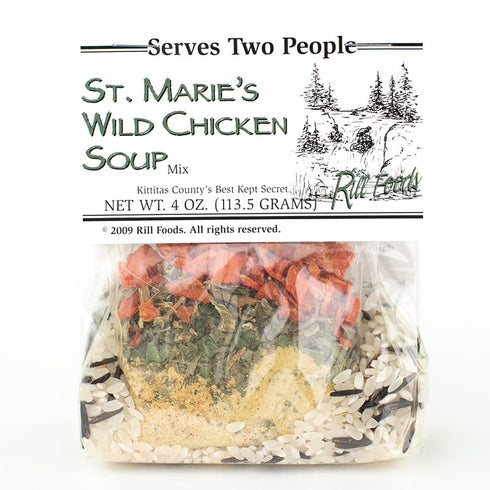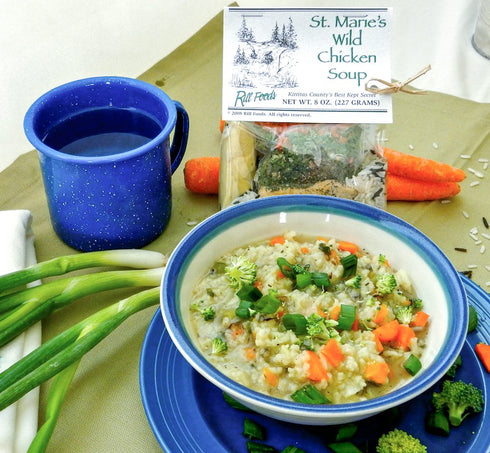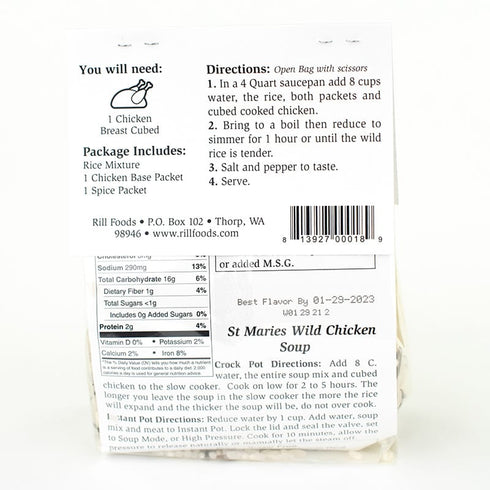Cooking Time
60 minutes
Serving Size
10 cups
Kettle Size
4 quarts
Ingredients
White rice, wild rice, dehydrated celery and carrots, herbs and spices, chicken base.
Available in small and large packages
Small: 4-5 1 cup servings
Large: 8-10 1 cup servings
Nutritional Facts for small package: Serv. Size 1 cup, Servings 5 Amount Per Serving: Calories 90, Fat Cal 5, Total Fat 0g (0% DV), Sat Fat 0g (0% DV), Cholest.0mg (0% DV), Sodium 690mg (29% DV), Total Carb. 20g (7% DV), Fiber 1g (4% DV), Sugars 2g, Protein 3g, Vitamin A (15% DV), Vitamin C (2% DV), Calcium (2% DV), Iron (6% DV). Percent Daily Values (DV) are based on a 2000 calorie diet.
 Product of Washington State
Product of Washington State

Rill's Specialty Soups are a Product of Washington State.
Great Ideas for Dressing up your St. Marie's Wild Chicken Soup
| Add | Your favorite vegetables Try zucchini or summer squash |
| Serve with | Dumplings |
| Vegetarian | Remove yellow chicken base packet and use vegetable broth |
Tidbits of Wild Rice History
Centuries ago, wild rice grew naturally in the soft, muddy bottoms of shallow lakes and rivers of Minnesota, Ontario and southern Manitoba. Sioux and Chippewa Indians depended on wild rice, or "Manomin" meaning good berry, to meet their vegetative dietary needs. Manomin's value lay in the high protein content and indefinite storage capabilities. Often these qualities made the difference between life and death during the harsh winter months. During the fall, tribes would set up camps along the lakes and rivers in anticipation of the harvest. Many wars among the Indian tribes ensued over the wild rice stands.
The responsibility of harvesting wild rice fell upon the Indian women. Explorers reported observing the women moving through the water in birch-bark canoes while grasping wild rice stalks. Afterwards, the wild rice would be cured. By curing the wild rice, the Indians would be able to store the grain without the threat of it spoiling.
Three methods could be employed to cure wild rice. First, wild rice could be spread out on blankets or mats in the sun. Second, wild rice could be spread out on racks under a fire, which served as the source of curing heat. Last, wild rice could be poured into a large kettle, placed over a slow fire, and stirred constantly. Once the curing process was completed, the men would thresh the tough hulls. On average, one family produced five bushels of wild rice, each weighing 300 pounds.
In the 1600s, French fur traders and voyagers began commercializing wild rice, the seed of an annual aquatic grass. During the early 1900s, wild rice started drawing the attention of white settlers and businessmen. In the 1920s, the first large scale processing and packaging factory was developed in Minnesota. In the 1940s, the annual production of wild rice stood at 200,000 pounds. By 1973, the annual production rose to 1,500,000 pounds.
Minnesota boasts more acres of naturally occurring wild rice than any other state in the U. S. Wild rice grows in forty-five of the eighty four counties and is spread through all sections of the state.
St. Marie’s Wild Rice grows in the lush fields of Northern Idaho. At the turn of the 20th century, bird hunters brought the grain from Minnesota to the Pacific Northwest in hopes of increasing the bird population of the area. They believed the rice would turn prosper in the deltas of this area, and in turn nourish the local wild life.
When cooked, wild rice weighs four times more than when it is dry.
Free Shipping -
All orders of $50 or more qualify for free shipping excluding Traxxas RC vehicles. RC vehicles ship for $9.99 - $12.99 each (in-state vs. out of state).
Free Local Delivery -
Within Kittitas County (M-F)
Returns & 100% Money Back Guarantee -
If within the first 15 days after receiving your order you would like to return your item(s) for any reason, call 509-925-9851 or email Order@Jerrols.com and we will email you a return label to print and use to ship back to us via USPS.








